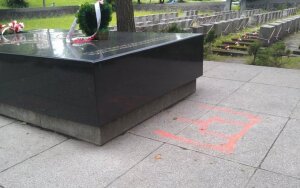- June 18, 2012
- 535
The Columns of Gediminas on Józef Piłsudski’s tomb

Last weekend, presumably on Saturday night (16/17 June), unknown perpetrators painted the Columns of Gediminas on Józef Piłsudski’s tomb in Rasos Cemetery. The police have launched an investigation.
“We consider it was an act of vandalism” – said Ewa Figel, the Minister – Counsellor of the political – economic section of the Embassy of the Republic of Poland in Vilnius. Yesterday, between 1 and 2 PM the Polish embassy in Vilnius was informed by some guides showing Polish tourists around Vilnius that somebody had painted the Columns of Gediminas on the tomb in which the Marshal’s heart and his mother Maria Piłsudska are buried. The embassy duty consul Piotr Wdowiak arrived on the scene immediately and called the police. They arrived in about two hours. According to Ewa Figel, the police approached the issue professionally. There were experts who documented the scene and carried out all the required procedures.
A news agency BNS announced that the police called also the cemetery workers who noticed the painting. Yesterday, the information about the incident was commented on Facebook and a few blogs.
The police have launched an investigation. Robertas Daugėnas the assistant commissioner of the second police station in Vilnius, when talking to PL DELFI, said that the investigation is in progress and he cannot give any information without the prosecutor’s being in charge of the investigation sanction.
Audronė Šukienė, a prosecutor of the Vilnius Regional Prosecutor’s Office, also could not offer any thorough explanation. “There haven’t been any suspects yet. I cannot tell when exactly I will know something more. The investigation is in progress” – said the prosecutor.
The Columns of Gediminas are one of the earliest symbols of Lithuania and one of its historical coats of arms, sometimes used together with the official coat of arm the Pahonia. The Columns of Gediminas were a family symbol used by Grand Duke of Lithuania Gediminas, his son Kęstutis, grandsons Vytautas and Jogaila (later Władysław II Jagiełło), and other descendants. The Columns of Gediminas can be also seen on the coat of arms of Senieji Trakai, one of the historical capitals of Lithuania.
Yesterday, when the police had carried out all the required procedures, the painting was removed.
Józef Piłsudski’s heart was buried in his mother’s grave in Rasos Cemetery in Vilnius in 1935. It was his wish to carve quotations from Wacław (at the top) and Beniowski (at the bottom) by Juliusz Słowacki on the black, granite tombstone of the Mother and the Son’s Heart mausoleum.
Ažubalis strongly disapproves of acts of vandalism
On Sunday the Columns of Gediminas were painted also on the walls of St. John Bosco Church in Vilnius. The Minister of Foreign Affairs of Lithuania Audronius Ažubalis made a statement in which he strongly disapproved of the two acts of vandalism. According to the minister, destroying graves, monuments or churches by certain people proves they (the people) are degenerate. The minister stressed that very often graffiti painted by some vandals stirs up hatred and heightens racial or ethnic tensions. “In such cases, paint becomes not only a stain on a stone, but also a scar on relations between different nations and on hearts of all the people of goodwill” – wrote the minister.
The minister reminded also of the project of amendments to the Criminal Code that he had presented to the Seimas last year in which he suggests bringing to justice those who paint graffiti in certain places.
Tłumaczenie Małgorzata Mitoraj w ramach praktyk w Europejskiej Fundacji Praw Człowieka, www.efhr.eu. Translated by Małgorzata Mitoraj within the framework of a traineeship programme of the European Foundation of Human Rights, www.efhr.eu.

